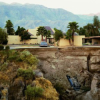Joel Sternfeld

Joel Sternfeld
Joel Sternfeldis a fine-art color photographer noted for his large-format documentary pictures of the United States and helping establish color photography as a respected artistic medium. He has many works in the permanent collections of the MOMA in New York City and the Getty Center in Los Angeles. He has influenced a generation of color photographers, including Andreas Gursky, who borrows many of Sternfeld's techniques and approaches...
NationalityAmerican
ProfessionPhotographer
Date of Birth30 June 1944
CountryUnited States of America
I could get my camera and point it at two people and not point it at the homeless third person to the right of the frame, or not include the murder that's going on to the left of the frame.
Black and white is abstract; color is not. Looking at a black and white photograph, you are already looking at a strange world.
I grew up in Belle Harbor, which is in New York City, but it has the most powerful sense of nature and seasons. It wasn't even the beach and the water. I just dreamt about everything that had to do with nature. I read about Thoreau.
No one can say how long the process of human extinction might take, but as it proceeds, the same global order will prevail that always prevails: rich nations will find ways to protect themselves and make themselves comfortable, while the poor nations and the poor people of the planet will suffer.
With a photograph, you are left with the same modes of interpretation as you are with a book. You ask: 'What do we know about the author and their background? What do I know about the subject?'
All of my work has been about ideas of utopia and dystopia. I think that's what gives America interest. It's many things all at once. It's such a complicated society.
You take 35 degrees out of 360 degrees and call it a photo. No individual photo explains anything. That's what makes photography such a wonderful and problematic medium.
A photographer must choose a palette as painters choose theirs.
Photography has always been capable of manipulation.
When you have unity, I think it squares the reach or power of the work.
Even the photographs of Henri Cartier-Bresson, with all due respect to him, are notoriously burned and dodged.
The digital print is becoming the look of our time, and it makes the C-print start to look like a tintype.
For me it was sort of career suicide to work in color, but I did it because I perceived myself from an early stage to be interested in seasonality - the changing of the seasons - thats what I deeply loved.
Some people consider utopia to be derived from nature. For some people, utopia is the city.